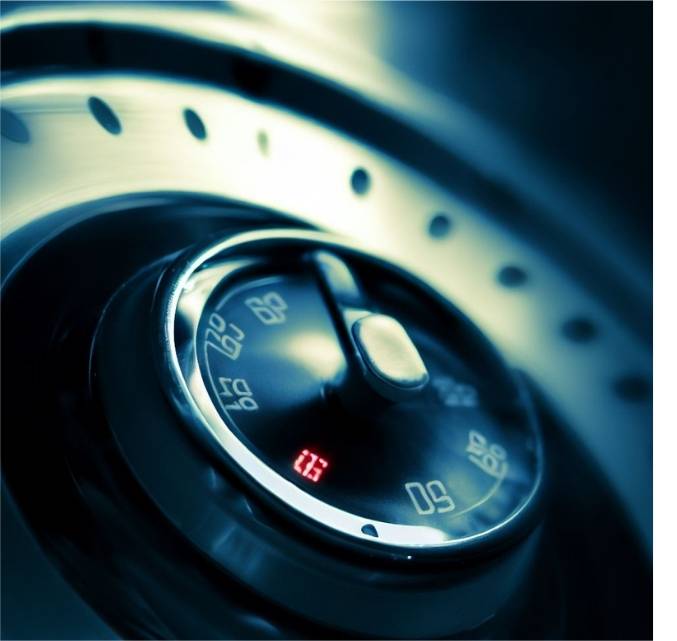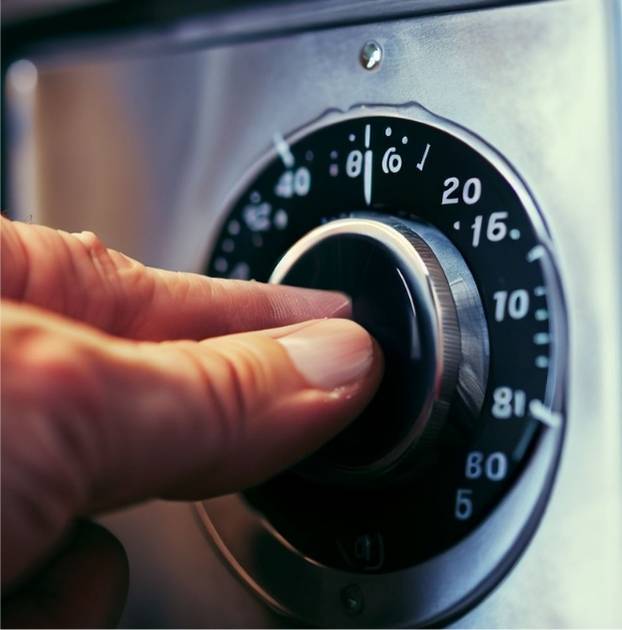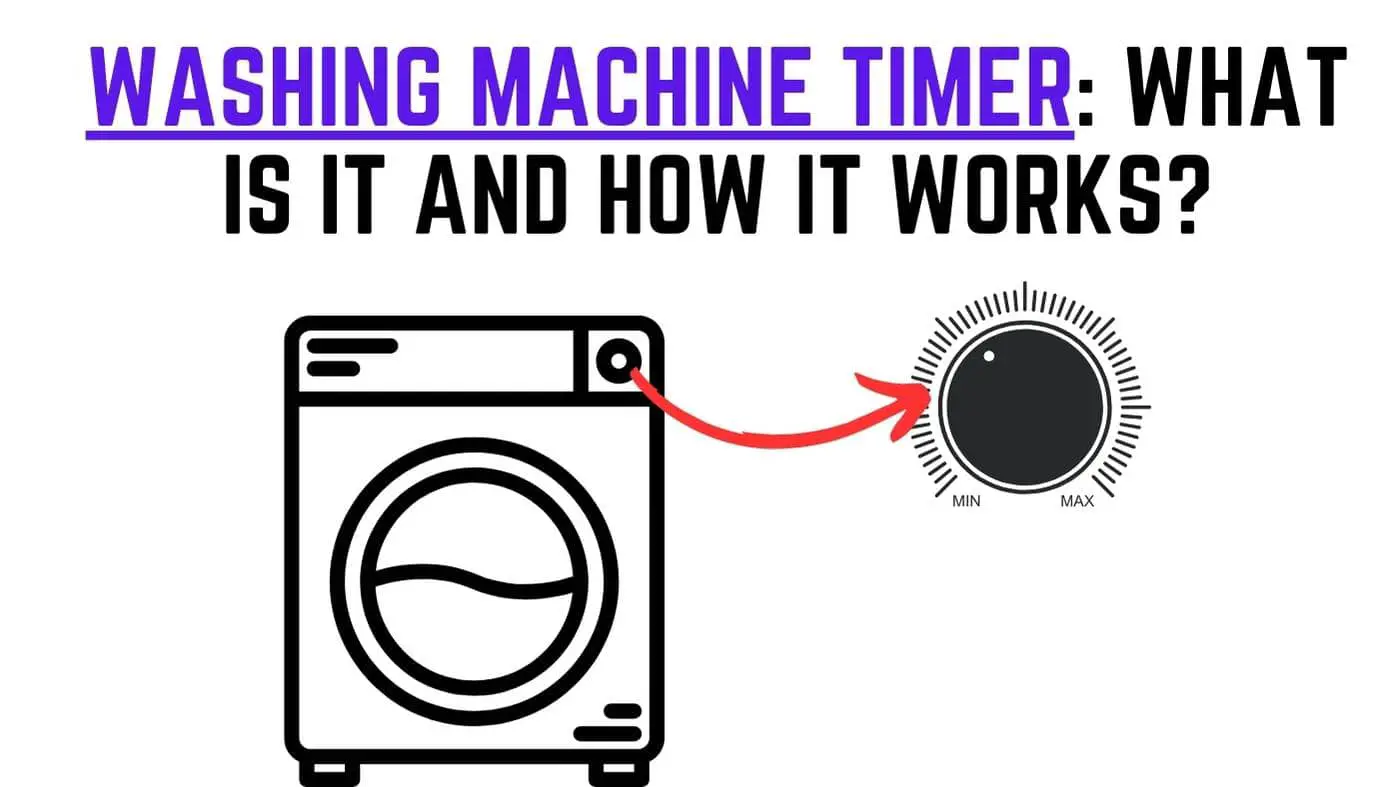If you’ve ever wondered what happens behind the scenes when you set the timer on your washing machine, you’re in the right place.
In this blog post, we’ll dive deep into the working of washing machine timers and demystify their role in your daily laundry routine.
Table of Contents
What is a Washing Machine Timer?

A washing machine timer serves as the brain of the appliance, controlling the sequence and duration of each operation during the wash cycle. So, it is a crucial component in both manual and automatic washing machines.
Whether it’s a mechanical dial or a digital interface, the timer is the part you interact with when setting your machine to wash, rinse, and spin your clothes.
What is the Purpose and Function of the Timer Component on a Washing Machine?
The timer in a washing machine helps to manage the various operations that your washing machine performs. It acts as a kind of ‘conductor,’ ensuring that each section of the wash cycle happens in the correct sequence and for the right amount of time.
Here’s a more detailed look at how the timer controls different functions:
Filling with Water: When you start a wash cycle, the timer sends a signal to open the water inlet valve, allowing water to flow into the drum.
Agitating the Clothes: After the machine fills with water, the timer triggers the washing machine motor to agitate the clothes. This motion helps remove dirt and stains.
Draining the Water: When the agitation phase is complete, the timer signals the drain valve to open, allowing the dirty water to be expelled.
Spinning the Clothes Dry: Finally, the timer sets off the spin cycle, which removes excess water from the clothes.
What does 3h 6h 9h mean?
3h 6h or 9h on your washing machine simply refers to the delay timer settings. This feature allows you to schedule the start time of your wash cycle to suit your needs.
Specifically, the “3h” setting means there will be a 3-hour delay before the wash cycle begins, “6h” indicates a 6-hour delay, and “9h” signifies a 9-hour delay.
For instance, if you set your washing machine timer to “6h,” the machine will initiate the wash cycle exactly 6 hours after you’ve programmed it. This is extremely helpful for various reasons:
- Timing: You can have your laundry freshly washed right when you need it, whether it’s first thing in the morning or when you return home from work.
- Cost-Efficiency: If your utility company charges less for electricity during off-peak hours, you can use these delay settings to reduce your energy bills.
It’s essential to note that the exact symbols and functionality may differ between washing machine models.
Therefore, it is advisable to consult your washing machine’s user manual for precise instructions on using this feature effectively.
Also Read: What is Delay End feature in a Samsung washing machine?
Types of Washing Machine Timers
When it comes to types of washing machine timers, there are primarily two categories that you’ll encounter i.e., mechanical washing machine timers and electronic washing machine timers.
Both have their advantages and disadvantages, and the choice between the two often depends on your specific needs and preferences.
Mechanical Timers
Mechanical timers are the traditional type, you’ll find these mostly in older washing machine models.
They operate using a series of gears, cams, and switches.
When you turn the washing machine timer knob, these mechanical components work in sync to control the various phases of the wash cycle.
- Advantages: Mechanical timers are generally more robust and can last for many years. They are also typically easier to repair.
- Disadvantages: They offer fewer features and are not as precise as their electronic counterparts. The timer settings are often limited to predetermined intervals.
How does a Mechanical Washing Machine Timer work?
Understanding how a mechanical washing machine timer works can be fascinating, especially if you’re keen on the mechanics of everyday appliances.
A mechanical timer operates through a well-orchestrated interplay of gears, cams, and contact switches.
Here’s how each component contributes to the overall function:
Gears and Cams
Inside the mechanical timer, a set of gears and cams are connected to the washing machine timer motor.
When activated, these gears rotate the cams at specific intervals, designed to coincide with various phases of the wash cycle.
- Gears: These are responsible for the movement and timing accuracy. They are precisely designed to rotate the cams at calculated speeds and intervals.
- Cams: These are uniquely shaped pieces that interact with contact switches. Their shape and rotation pattern determine when a particular switch is engaged or disengaged.
Contact Switches
Contact switches are electrically conductive components that either complete or break an electrical circuit when activated.
The cams’ rotation controls these switches, leading to the activation or deactivation of different machine functions like filling water, agitating, draining, and spinning.
Timer Knob
The washing machine timer knob is the user interface of the mechanical timer.
It’s what you turn to select the type and length of the wash cycle.
The knob is directly connected to the gears and cams.
When you turn it, you manually set the initial position of the gears and cams, which then dictates the ensuing washing machine timer cycle.
The mechanical timer is a complex yet robust system, when you’re setting a washing machine timer, you’re essentially priming this mechanical orchestra to perform its regular function i.e., wash, rinse, and spin.
Though not as advanced as electronic timers, mechanical timers offer reliability and ease of washing machine timer repair.
Electronic Timers
Electronic timers are a more modern development and are commonly found in newer, high-end washing machines.
These timers utilize a microcontroller and electronic switches to operate the machine.
- Advantages: Electronic timers offer more precise control over the wash cycle. They often come with digital displays and offer a wider range of features, including customized wash cycles.
- Disadvantages: They are generally more expensive to repair or replace if they malfunction. The washing machine timer circuit in electronic timers is also more susceptible to power surges and other electrical issues.
How does an Electronic Washing Machine Timer work?
Electronic Washing Machine timers are built around digital technology, primarily using microcontrollers, electronic switches, and digital displays to execute and indicate the washing cycle.
Here’s a breakdown of each component in the electronic washing machine timer:
Microcontroller
At the heart of an electronic timer is a microcontroller, a small computer on a single integrated circuit.
The microcontroller receives input from the user interface, processes it, and sends out corresponding signals to control the various functions of the washing machine.
- Programming: Microcontrollers can be programmed to handle a multitude of tasks, from basic to complex custom cycles.
- Precision: They offer more precise control over the wash cycle compared to mechanical timers.
Electronic Switches
Unlike the contact switches in mechanical timers, electronic timers use electronic switches like transistors and relays.
These switches are controlled by the microcontroller and are used to turn different machine functions on and off.
- Efficiency: Electronic switches are generally more energy-efficient and offer quicker response times.
- Versatility: They can be easily programmed to handle various tasks, offering a wider range of features than mechanical switches.
Digital Display
The digital display serves as both an input and an output interface for the user.
It allows you to select different washing options, view the time remaining in the wash cycle, and even troubleshoot issues through error messages.
- User-Friendly: Digital displays are generally easier to read and offer more information than the washing machine timer dial found in mechanical timers.
- Customization: The digital interface often allows for more customized wash cycles, giving you greater control over how your clothes are washed.
In essence, an electronic timer offers a high level of customization and precision, although it comes at the cost of being more complex and generally more expensive to repair.
But for those who prefer advanced features and settings, the electronic washing machine control is a worthy investment.
How to Set and Use a Washing Machine Timer?

Whether you have a mechanical or electronic timer, knowing how to properly set and use it is crucial for an efficient laundry routine.
Here’s a simple guide on setting a washing machine timer and using it effectively:
Setting the Wash Cycle
Mechanical Timer: Turn the washing machine timer knob to the desired cycle length and type, which are usually marked on the dial. Make sure to align the indicator on the knob with the markings on the dial.
Electronic Timer: Navigate through the options on the digital display using the control buttons. You can select the type of wash, spin speed, water temperature, and other settings.
Starting the Washing Machine
Mechanical Timer: Once you’ve set the timer, pull the washing machine timer knob out or press the start button, depending on your machine’s design, to initiate the wash cycle.
Electronic Timer: Press the ‘Start’ button after setting your desired options. The washing machine timer control will display the time remaining and other details on the digital screen.
Pausing and Stopping the Washing Machine
Mechanical Timer: To pause the machine, simply push the washing machine timer knob back in. To stop it completely, turn the knob to the ‘Off’ position.
Electronic Timer: Most digital timers offer a ‘Pause’ button that allows you to temporarily halt the wash cycle. To stop it entirely, you usually need to hold the ‘Stop’ or ‘Cancel’ button for a few seconds.
Understanding how to set and use your washing machine timer ensures that you get the most out of your appliance.
Whether you have a mechanical or automatic washing machine timer, the key is to be familiar with your machine’s specific functionalities, usually detailed in the user manual.
Troubleshooting Washing Machine Timer Problems

When it comes to laundry, a malfunctioning washing machine timer can be a significant inconvenience.
Here are some common issues and their respective solutions to help you with troubleshooting washing machine timer problems.
Why does the washing machine timer change?
If you notice that the time on your washing machine’s display changes unexpectedly or the washing machine timer dial seems to jump, it could be due to:
- Sensor Feedback: Modern machines adjust time-based on internal sensors that measure water level, load imbalance, or suds.
- Power Fluctuations: Sudden power cuts or surges can also affect the timer.
Solution: Reset your machine by unplugging it for a few minutes and then restarting the cycle. If the problem persists, consult the user manual or seek a professional washing machine timer repair.
Why does my washing machine stop after 5 minutes?
Stopping abruptly after a few minutes is often a symptom of a washing machine timer problem or other issues like:
- Overloading: The machine might stop if it detects that it’s overloaded.
- Faulty Sensors: Sometimes, malfunctioning sensors can send incorrect signals to the timer.
Solution: Check for overloading and ensure that the sensors are clean. If the issue remains, it might be time to consider a washing machine timer replacement.
Why are wash cycles so long?
Longer-than-expected wash cycles can be perplexing and frustrating. Reasons might include:
- Calibration: Some machines have an initial calibration cycle that takes longer than usual.
- Auto-Sensing Features: Modern machines may adjust cycle times based on load size or soil level.
Solution: Consult your user manual to understand how auto-sensing features work. If it’s a recurring issue, it might be a washing machine timer control problem requiring professional attention.
Other Common Issues and Solutions
- Washing Machine Timer Not Advancing: If the timer is stuck and not advancing, it may require cleaning or washing machine timer repair.
- Washing Machine Timer Not Working: Check for loose connections or faulty wiring. If these are not the issues, you might need a washing machine timer replacement.
Final Thoughts
Understanding your washing machine timer is crucial for efficient laundry routines and troubleshooting.
Whether it’s a mechanical washing machine timer with its robust gears and cams, or an electronic washing machine timer with advanced microcontrollers and digital displays, each has its unique features and potential issues.
Familiarizing yourself with how these timers work can help you make informed decisions, whether you’re buying a new machine or troubleshooting washing machine timer problems.
Always read the user manual for specific guidance and consider professional help for complex repairs or replacements.
You May Also Like
- How to Use Time Delay On Washing Machine? (Guide)
- How to replace the timer in a dryer?
- How to replace the timer switch in a Washing Machine?
- Washing Machine Programs: A Beginner’s Guide
- Portable Washer Energy Consumption: Save up to 50%
- How to replace the pressure switch in a washing machine?
- Where is the fuse in Maytag top load washer located?

